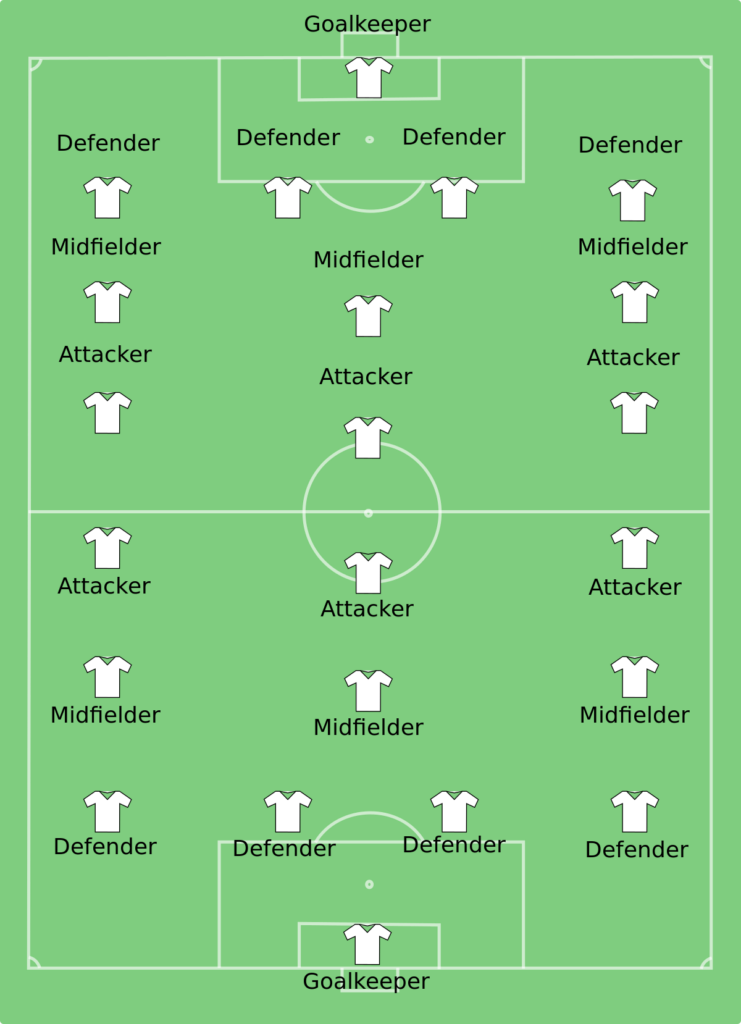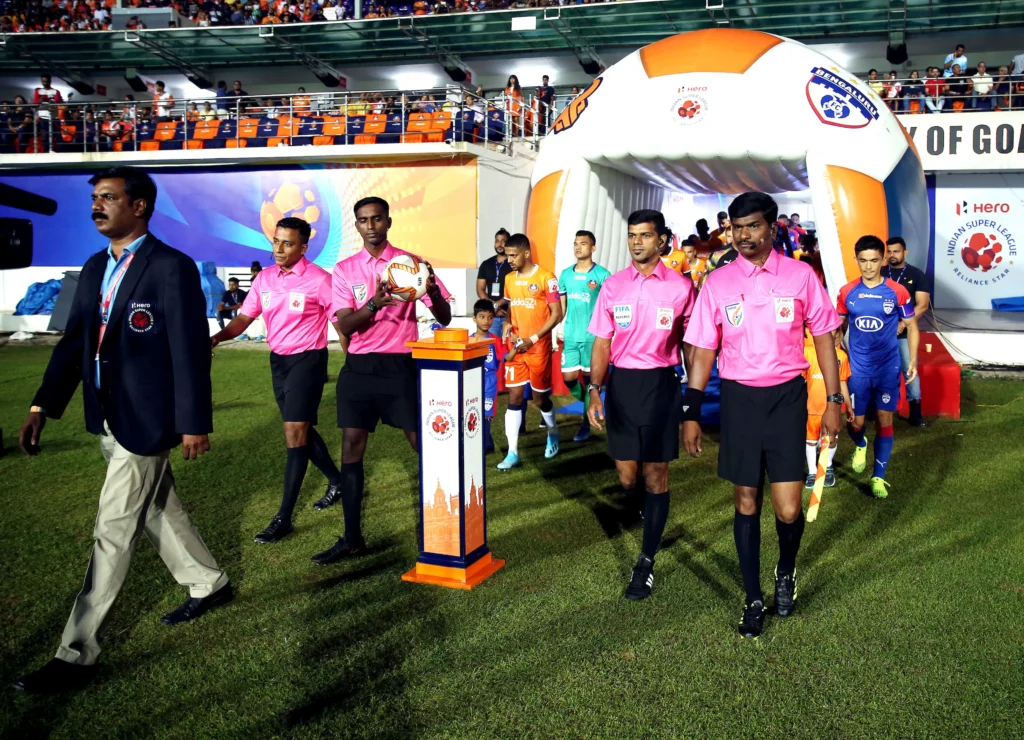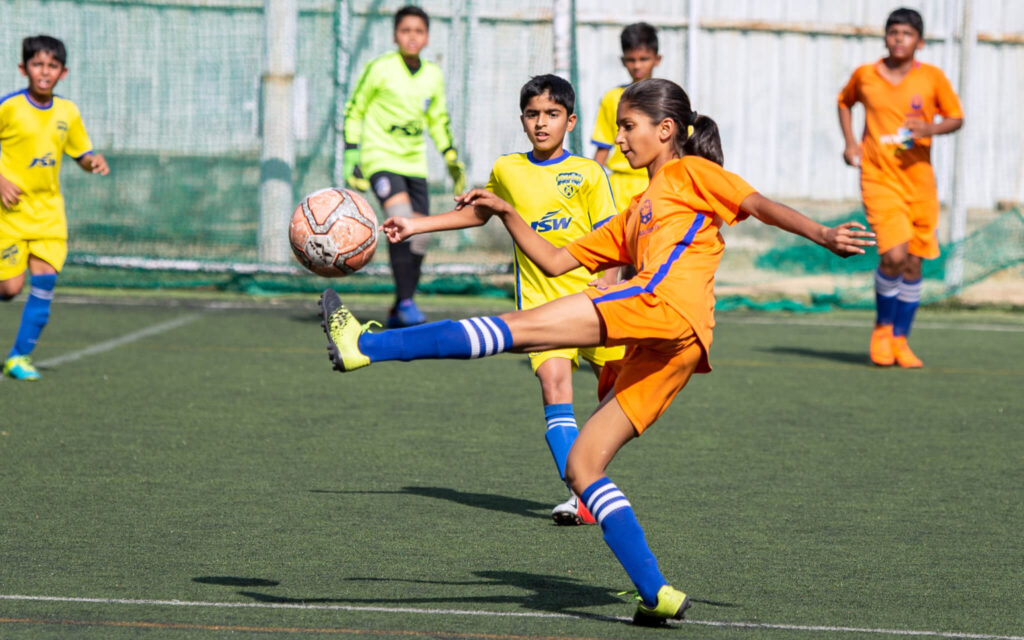Stay tuned to learn more about the world of football and how it has become a global phenomenon. And if you’re looking for a reputable sports betting site to place your bets on football, check out in LottaBet article.
How Many Players are There in Football? A Complete Guide to Team Size
Welcome to the world of football, where the number of players in a team can make all the difference. A football team consists of 11 players, including a goalkeeper who plays a crucial role in protecting the team’s goalpost. Football, also known as the beautiful game, is a popular sport that is played on a rectangular field. This field has two goalposts on either side, and the objective of the game is to score as many goals as possible. Football matches can be intense and exciting, and it’s no surprise that it’s become one of the most popular games around the world, including India.
If you’re interested in sports betting, you’ll find that football is one of the most popular sports to place bets on. The football association has strict rules and regulations regarding the number of players in a team, the size of the football field, and other factors that influence the outcome of a game. In this article, we’ll provide you with a complete guide to team size in football, including the different positions players can play, the role of the team captain, and the significance of grassroots football.
Table of Contents
- 1 The Composition of a Football Team
- 2 Football Positions and Roles
- 3 Substitutions in Football
- 4 The Role of the Team Captain
- 5 Football Referees and Match Officials
- 6 Responding to In-Game Infractions
- 7 Special Scenarios: Extra Persons, Goals, and Player Adjustments
- 8 Grassroots Football and Modern Trends
- 9 Conclusion
- 10 FAQ
- 10.1 How many players are there in a football team?
- 10.2 What are the positions in a football team?
- 10.3 Can players be substituted during a football match?
- 10.4 What is the role of the team captain in football?
- 10.5 What is the role of referees and match officials in football?
- 10.6 What happens in special scenarios like extra persons, goals, and player adjustments?
- 10.7 What is the significance of grassroots football?
The Composition of a Football Team
Football is a team sport played on a rectangular field, and a team consists of eleven players, including a goalkeeper and ten outfield players. The goalkeeper is the only player allowed to use their hands and primarily stays inside the penalty area defending the goal. The other ten outfield players are divided into defenders, midfielders, and forwards, each with distinct roles and responsibilities.
The team consists of four defenders, positioned in front of the goalkeeper, and three or four midfielders, who play in the central area of the field. The remaining two or three players are forwards, who play at the front of the field, near the opponent’s goal.
The goalkeeper is the last line of defense and responsible for preventing the opponent from scoring goals. The defenders aim to stop the opposition’s forwards from getting into a scoring position. Midfielders link the defense and the forwards, controlling the rhythm of the game and providing support on both sides of the field. The forwards are the attacking players who aim to score goals.
| Position | Number of Players |
|---|---|
| Goalkeeper | 1 |
| Defender | 4 |
| Midfielder | 3 or 4 |
| Forward | 2 or 3 |
The number of players in each position can vary depending on the team’s formation, which is the tactical arrangement of players on the field. Some teams may have an extra midfielder or forward, depending on their tactics and the strengths of their players.
Understanding the composition of a football team is crucial for anyone interested in watching or betting on football matches. A team’s performance depends on the coordination and chemistry of its players and their ability to work together strategically.

Football Positions and Roles
Football is a team sport that requires different roles and positions to ensure the effective functioning of a team. Each position has a specific function, and players must work together to achieve a common goal, which is to score more goals than the opponents. Here is a breakdown of some of the significant football positions:
Offensive players
Offensive players are responsible for creating and scoring goals. The forwards or strikers are the primary offensive players who lead the attack and play closest to the opponent’s goal. They are supported by wingers who operate on either flank. Wingers are responsible for providing crosses into the box or cutting inside to create goal-scoring opportunities. The attacking midfielder or the playmaker is another offensive player who plays behind the strikers and is responsible for creating chances and assists.
Central midfielders
Central midfielders are the engine of the team. They link the offensive and defensive departments and are responsible for maintaining possession of the ball and dictating the tempo of the game. The box-to-box midfielder is a central midfielder who is energetic and covers the entire pitch, contributing both offensively and defensively. The deep-lying playmaker or defensive midfielder primarily focuses on defensive duties, tackling, and breaking up opponent’s attacks.
Central defenders
The central defenders are the mainstay of the defense. They play in the center of the defense, provide cover to the goalkeeper, and help to prevent the opponents’ forwards from scoring. They are strong, athletic, and excellent in the air, making them crucial in defending set-pieces.
Defensive midfielder
The defensive midfielder is positioned just in front of the defense and acts as a screen to protect the defenders. The defensive midfielder’s primary responsibility is to break up the opponent’s attacks and regain possession of the ball. They also help in starting the team’s offensive play by distributing the ball to the central midfielders or the attacking players.
Midfield players
The midfielders are responsible for connecting the defense to the attack. They support the defense by tracking back and defend when necessary, and also assist the attack by providing passes to the forwards or the attacking midfielder.

Substitutions in Football
In football, teams are allowed to make substitutions to replace players on the field. Substitutions can be made for a variety of reasons, including injury, fatigue, or tactical changes. The substituted player must leave the field and cannot return to the same match unless it’s a friendly or have already been used in a tournament which allows additional substitutes.
Each team is allowed a specific number of substitutions per match, which may vary depending on the competition or tournament rules. In football leagues like the Premier League, a team is allowed to make three substitutions per match. In some competitions, such as the Champions League, a team is allowed to make up to five substitutions per match.
It is essential for teams to have a deep and talented roster to ensure that they can make effective substitutions when necessary. In some cases, a team may have a designated “super-sub” who is known for making a significant impact when they come on as a substitute.
Active Roster
The active roster is a list of players who are eligible to participate in a match. The number of players on the active roster may vary depending on the competition or tournament rules. For example, in the Premier League, a team can have up to 25 players on its active roster.
It is important for teams to manage their active roster effectively to ensure that they have enough depth and coverage in each position. In some cases, a team may need to make adjustments to its active roster due to injuries, suspensions, or other factors.
The Role of the Team Captain
In football, the team captain is a crucial player who leads their team on and off the field. The captain is typically one of the most experienced players on the team, chosen for their leadership skills and ability to inspire their teammates.
The captain’s role is to communicate with the referee and opposing team captain, make tactical decisions, and motivate their team to perform at their best. They are also responsible for guiding their team in attack and defense, making them an essential part of the team’s overall strategy.
When it comes to attacking, the team captain plays a pivotal role in orchestrating attacks against the opponent’s defense. Their awareness of the game and their ability to analyze the opposition’s playstyle allows them to make quick decisions on the field, leading to successful attacks.
| Key Responsibilities of a Team Captain | Tactics |
|---|---|
| Leading by Example | The captain must lead by example and demonstrate the values they expect from their team. |
| Communication | The captain must communicate effectively with their teammates to ensure they are on the same page. |
| Motivation | The captain must motivate their team to perform at their best level throughout the match. |
| Strategy | The captain must make tactical decisions that benefit their team and help them achieve their objectives. |
In conclusion, the team captain is a vital player in any football team. Their leadership, tactical knowledge, and ability to motivate their teammates are essential in guiding a team to victory. On the attacking front, they play a central role in orchestrating attacks against the opponent’s defense.

Football Referees and Match Officials
Every football match has a team of match officials tasked with enforcing the rules and ensuring a fair game. These officials are appointed by the respective football associations and are responsible for maintaining order and safety on the field.
The match officials include the referee, assistant referees, fourth official, and VAR officials, where applicable. The referee is the head official and has the final say in all decisions related to the game. They are responsible for stopping and starting the game, awarding free kicks and penalties, and maintaining discipline on the field.
The assistant referees are responsible for making offside calls and signaling when the ball goes out of bounds. The fourth official assists the referee in managing the substitutes and any stoppages in play. VAR officials are responsible for reviewing controversial decisions made by the referee and advising them on the correct course of action.
The Importance of Match Officials
Match officials play a crucial role in ensuring a fair and safe game for all players and spectators. They are responsible for enforcing the rules of the game and preventing any unsportsmanlike conduct that may lead to injury or penalty. Without match officials, football matches would be chaotic and prone to unfair play, ultimately diminishing the enjoyment of the game.
Understanding Football Rules
Match officials must have a thorough understanding of all football rules and regulations to perform their duties effectively. These rules cover everything from the size and shape of the ball to the length of the game and the different types of free kicks. They also include regulations for player behavior and conduct, such as tackling, handball, and unsportsmanlike behavior.
It’s essential for football players and fans alike to understand these rules to appreciate the beautiful game fully. Familiarizing oneself with the regulations can also help one understand why certain decisions are made by match officials during a game.

Responding to In-Game Infractions
Football is a competitive sport that requires players to adhere to strict rules and regulations. When players commit infractions during a match, there are consequences that impact the outcome of the game. Two types of free kicks are used to respond to such infringements: direct free kicks and indirect free kicks.
A direct free kick is awarded to the opposing team when a player commits a serious offense, such as pushing, tripping, or striking an opponent. The team awarded the free kick is allowed to take a shot at the opponent’s goal or pass the ball to another player without interference from the defending team.
An indirect free kick, on the other hand, is awarded to the opposing team when a minor offense occurs, such as obstructing an opponent’s view or holding an opposing player’s jersey. The team awarded the free kick cannot make a direct attempt to score a goal, but must first pass the ball to another player before making a score attempt.
It is important for players to have a good understanding of the competition rules related to handling infractions. These rules dictate the type of free kick awarded, and how many players from each team are allowed to be present during a free kick. Violating these rules can lead to a yellow or red card, which will result in the player’s removal from the game.
Special Scenarios: Extra Persons, Goals, and Player Adjustments
In football, there are several special scenarios that can arise during a match, which require quick action to avoid potential penalties or rule violations. Here, we’ll explore the different scenarios and the rules surrounding them, including extra persons, goals, and player adjustments.
Extra Persons
There may be times during a game when an extra person enters the field of play. This could be a player or a member of the technical staff who inadvertently or deliberately enters the field without the referee’s permission. If this happens, then the play must stop immediately, and the extra person should be removed from the field. The referee will then restart the game with a dropped ball in the spot where the ball was when the play stopped.
Goals
The ultimate aim of football is to score goals. However, there are certain instances where a goal may be considered illegal, which may lead to a penalty or free-kick. If the ball passes over the goal line, between the goalposts, and under the crossbar, then a legal goal is awarded. However, if the ball is touched by an attacking player’s hand, the goal will be ruled out. Similarly, if the player is offside when the ball is played to them, the goal will be nullified.
Player Adjustments
There are instances where a team may need to make adjustments to their lineup during a game. This could be due to an injury to a player, a tactical change, or a substitution. When a team makes a substitution, the player being substituted must leave the field before the replacement enters. The referee must also be informed of the substitution before it takes place. Similarly, if a player is injured and requires treatment, they may need to temporarily leave the field for assessment and treatment. In this case, the referee will usually allow play to continue while the player receives treatment, and then they can return to the field once they are deemed fit to do so.
In conclusion, understanding and adhering to the rules surrounding special scenarios in football is crucial to the smooth running of a game. Extra persons, goals, and player adjustments can all impact the outcome of a match, so it’s important to be aware of the rules and regulations surrounding these scenarios.
Grassroots Football and Modern Trends
Football is not just a game of entertainment and competition, it is also a way of life for many people. Playing football at the grassroots level has an essential role in developing young players and nurturing their talent.
Grassroots football in India is growing rapidly, with more kids being introduced to the sport every day. The All India Football Federation (AIFF) has taken various initiatives to promote and support grassroots football throughout the country.
One of the most significant projects is the AIFF’s ‘Baby Leagues’ program, which aims to create a structured and regulated football competition for kids under 12 years old in over 30 cities across India. This program provides young children with the opportunity to learn and develop their football skills in a fun and safe environment.
Modern Football
Modern football has seen various technological advancements, from the introduction of VAR (video assistant referee) to advancements in sports science and analytics. Many football clubs across the world have started to adopt these modern trends to improve their performance on the field.
| Grassroots Football | Modern Football |
|---|---|
| Focused on developing young players and nurturing talent | Focused on technological advancements to improve performance |
| Emphasizes the importance of team spirit and sportsmanship | Emphasizes data analysis and strategic planning |
| Encourages active participation and teamwork | Encourages innovation and experimentation |
While modern trends and advancements have certainly had an impact on the sport, it is important to remember the grassroots level of football and the critical role it plays in fostering a lifelong love for the game.

Conclusion
In conclusion, football is a beloved sport worldwide, and its popularity shows no signs of slowing down. Football players are the heart and soul of the game, and their skills and teamwork are essential to winning any match.
One way to extend the thrill of the game is through football betting. There are many reputable sports betting sites, such as lottbet, that offer exciting opportunities to bet on football matches and potentially win big. So, if you’re a football fan looking to take your love of the game to the next level, consider exploring the world of football betting.
In addition to being a thrilling sport, football also has the power to nurture community and talent through grassroots efforts. By supporting these initiatives, we can help develop the next generation of football players and ensure the continued growth and success of the sport.
Whether you’re a seasoned football fan or a newcomer to the game, there’s always something new to discover and enjoy. So, get ready to cheer on your favorite football players and explore the exciting world of football betting!
FAQ
How many players are there in a football team?
A football team consists of 11 players – 1 goalkeeper and 10 outfield players.
What are the positions in a football team?
There are various positions in a football team, including offensive players, central midfielders, central defenders, defensive midfielders, and midfield players.
Can players be substituted during a football match?
Yes, player substitutions are allowed in football. The rules and regulations regarding substitutions may vary depending on the competition. Each team typically has a designated number of substitutions they can make throughout a match.
What is the role of the team captain in football?
The team captain in football has leadership responsibilities both on and off the field. They guide and motivate their teammates, communicate with the referee, and play a crucial role in orchestrating attacks against the opponent’s defense.
What is the role of referees and match officials in football?
Referees and match officials enforce the rules of the game and ensure fair play during matches. They make decisions on fouls, penalties, and other infractions, and their main objective is to maintain order and uphold the spirit of the game.
What happens in special scenarios like extra persons, goals, and player adjustments?
Special scenarios in football, such as situations involving extra persons, goals, and player adjustments, are handled according to specific rules and procedures. These scenarios are addressed to maintain fairness and the integrity of the game.
What is the significance of grassroots football?
Grassroots football plays a vital role in developing young players and nurturing talent. It provides opportunities for aspiring athletes to learn and grow in the sport, helping to shape the future of football.
- What Is Arbitrage Betting – A Complete Guide And Winning Strategies - July 25, 2024
- Value Betting Guide – How To Get The Most Value Out Of Making Bets - July 18, 2024
- Guide to Betting Markets: Big, Middle and Small - July 9, 2024


















